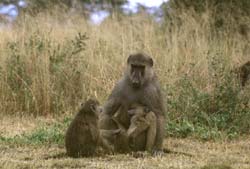Life Sciences and Chemistry
Articles and reports from the Life Sciences and chemistry area deal with applied and basic research into modern biology, chemistry and human medicine.
Valuable information can be found on a range of life sciences fields including bacteriology, biochemistry, bionics, bioinformatics, biophysics, biotechnology, genetics, geobotany, human biology, marine biology, microbiology, molecular biology, cellular biology, zoology, bioinorganic chemistry, microchemistry and environmental chemistry.

Targeting transcription: New insights into turning genes on
The 35,000 or so genes within a human cell are something like players on a sports team: If their activity isn’t controlled and coordinated, the result can be disastrous.
So just as coaches tell individual players when to scramble onto the field and when to stay on the bench, molecules called transcription factors prompt particular genes to be active or stay quiet. Transcription factors occur naturally in cells, but researchers have been working to develop artificial transcriptio

Chemists ID process to sort carbon nanotubes by electronic properties
Rice, UIUC researchers find way to separate metallic, non-metallic nanotubes
Researchers at Rice University and the University of Illinois at Urbana-Champaign have discovered the first method to chemically select and separate carbon nanotubes based on their electronic structure. The new process, described in the Sept. 12 issue of Science magazine, represents a fundamental shift in the way scientists think about the chemistry of carbon nanotubes.
“Other than low-cost mass prod

Coal-eating bacteria may improve methane recovery
Scientists at the U.S Department of Energy’s Brookhaven National Laboratory are exploring the use of bacteria to increase the recovery of methane, a clean natural gas, from coal beds, and to decontaminate water produced during the methane-recovery process.
Methane gas, which burns without releasing sulfur contaminants, is becoming increasingly important as a natural gas fuel in the U.S. But the process of recovering methane, which is often trapped within porous, unrecovered or waste co

Baboon Fathers Really Do Care About Their Kids
NSF-funded study suggests paternal care may be ancient trait in primates
In a finding that surprised researchers, a recent three-year study of five baboon groups at the foot of Mount Kilimanjaro in Kenya reveals that baboon fathers overwhelming side with their offspring when intervening in disputes.
The study, which appears in the Sept. 11 issue of the journal Nature, was funded by the National Science Foundation, the Chicago Zoological Society, the L.S.B. Leakey Foundati

Jefferson and Brigham and Women’s Researchers Find Blue Light Important for Setting Biological Clock
Researchers from Brigham and Women’s Hospital (BWH) in Boston and Jefferson Medical College have found that the body’s natural biological clock is more sensitive to shorter wavelength blue light than it is to the longer wavelength green light, which is needed to see.
The discovery proves what scientists have suspected over the last decade: a second, non-visual photoreceptor system drives the body’s internal clock, which sets sleep patterns and other physiological and behavioral functions.

Young sea animals clone themselves – century-old debate halted
After more than a century of intensive study, scientists have assumed that larvae of non-parasitic invertebrates reproduce only very rarely, but new research by University of Alberta scientists overthrows this conventional wisdom. Graduate student Alexandra Eaves and Dr. Richard Palmer, from the U of A’s Faculty of Science, have found that asexual cloning by some marine invertebrate larvae is not as rare and enigmatic a phenomenon as previously assumed.
“A wealth of knowledge of how em